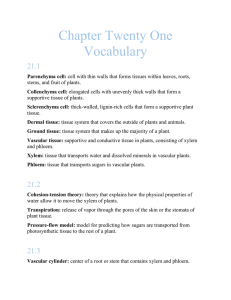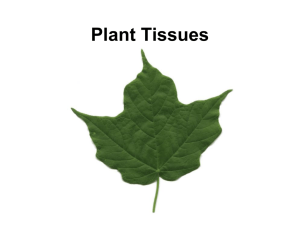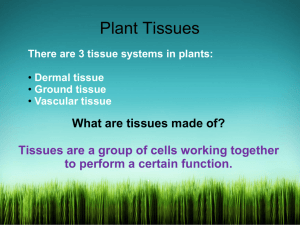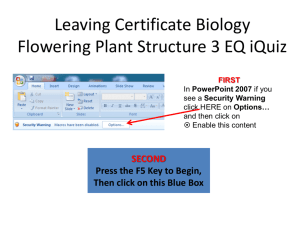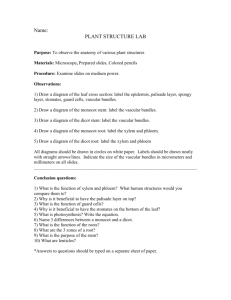File
advertisement
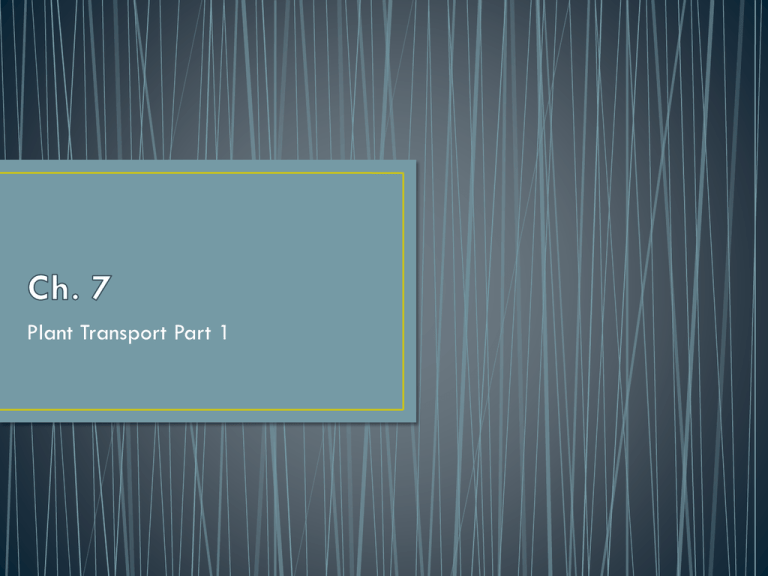
Plant Transport Part 1 Need for Transport Systems Take in substances from environment Get rid of waste (cell respiration) Transport Systems in Different Organisms Single-celled organism Transport occurs quickly No point in the cell is very far from the surface; diffusion from anywhere in the cell can occur quickly with cell membrane Gasses diffuse easily from any point within cell Large surface area to volume ratio Large, multicellular organism Diffusion NOT sufficient b/c: Centre of organism may be a long way to the surface It would take too long for substances to diffuse all the way Surface area to volume ration of cell is large Large, multicellular organism Diffusion NOT sufficient b/c: Centre of organism may be a long way to the surface It would take too long for substances to diffuse all the way Surface area to volume ratio of cell is large Solutions to transport problems: Transport Systems Increase surface area of parts of body involved in exchange with the environment Ex. Thin, flat leaves Ex. Highly folded gas exchange surface Ex. Cristae in mitochondria Ex. Grana (granum) Ex. Alveoli Transport in Plants Large organisms with branching shape (helps keep surface area to volume ratio large) Small energy needs compared to animals Role and structure of Leaves Respiration does not take place as quickly Rely on diffusion to supply cells with O2 and remove CO2 Thin large surface area inside in contact with air spaces Diffusion is sufficient to supply mesophyll cells with CO2 for photosynthesis and remove O2 Plant transport systems Do NOT transport gas 2 transport systems Two Transport Systems in Plants Xylem Transports water and inorganic ions from roots to other parts of plant Phloem Transports substances made in plant (sucrose and amino acids) to all parts of the plant Important:! • Do NOT transfer GAS • SLOW transfer (not rapid) • NO pump involved (like heart) Transport in Phloem Translocation movement of ORGANIC substances in phloem tissue Main substances moved (in solution): ASSIMILATES (substances that have been made by plants) Amino acids Sucrose Xylem: Water movement Driving force moving water: TRANSPIRATION Loss of water vapour from a plant Occurs mostly in leaves Contain many cells in contact with air spaces in the mesophyll layers Liquid water in cells changes to water vapour Water vapour then DIFFUSES into the air spaces Water vapour then diffuses out of the leaf through the STOMATA (down water potential gradient) into the air surrounding the leaf Guard cells control opening and closing of stomata (change shape depending on conditions) Photosynthesis requires OPEN stomata CO2 comes in and water vapour leaves Water loss is inevitable Factors Affecting Transpiration High Temp High Humidity High Wind Speed High Light intensity • Plant cells very similar to animal cells PLUS extra structures • Usually large than plant cells • Plant cell size varies • Cell wall of plants very different than cell membrane • Cell walls: thick, strong, freely permeable • Cell membrane: thin, partially permeable • Vacuoles are NOT confined to only plant cells • Plant cells have LARGE, PERMENENT CENTRAL vacuole • Animal cells have SMALL, TEMPORARY PHAGOCYTIC vacuoles • Plasmodesmata (singular: Plasmodesma) • Fine strands of cytoplasm that connect neighboring plant cells • Pass through pore-like structures in cell walls • Movement through pores is thought to be controlled by the structure of the pores • Cells • Basic unit of life; specific function • Tissues • Specialized groups of similar cells with common function • Organs • Specialized groups of tissues working together to perform a specific task • System • Group of specialized organs that work together to perform a common task • Xylem Cells • Phloem Cells • Histology: study of tissue • Collection of cells and any intercellular secretion produced by these cells that are specialized to perform particular functions • Maybe same type of cell • Ex: parenchyma in plants • Ex. Squamous epithelium in animals • Maybe mixed type • Xylem and phloem in plants\cartilage, bone, blood, and connective tissue in animals • Dermal Tissue • • • • Protective outer covering of plant Young plantssingle layer of cells Older plantscan be many layers thick In roots, dermal tissue includes root hairs • Vascular Tissue • Supports plant body • Transports water and nutrients throughout plant • Two types: xylem and phloem • Ground Tissue • • • • • Neither dermal nor vascular Produces and stores sugars Contributes to physical support of plant Edible parts of potato, asparagus, squash are made of ground tissue Can Consist of three types of cells: • PARENCHYMA cells (thin cell wall and large central vacuole) • In leaves, parenchyma cells contain many chloroplasts • COLLENCHYMA cells have strong flexible cell wall; help support plant organs • Strings in celery is made of long chains of collenchyma cells • SCLERENCHYMA cells have EXTREMELY thick cell wall • Makes strong ground tissue such as seed coats • Sclerenchyma fibers are used to make rope; shell of walnut • Part of body of organism which forms a structural and functional unit • Composed of more than 1 tissue • Examples of plant organs: • Leaves • Stems • Roots • Examples of animal organs: • • • • Brain Heart liver Eye kidney • Collection of organs with particular function • Examples in plants: • Vascular System (xylem and phloem) • Examples in animals: • Excretory system • Reproductive system • Cardiovascular system • Digestive system • Monocots • Dicots • Dermal Tissue • Epidermis • Vascular Tissue • Pericycle • Xylem • Phloem • Ground Tissue • Cortex • Endodermis • Epidermis: surface of the stem made of a number of layers often with a waxy cuticle to reduce waterloss. • Cortex Tissue: Forming a cylinder of tissue around the outer edge of the stem. Often contains cells with secondary thickening in the cell walls which provides additional support. • Vascular bundle: contains xylem, phloem and cambium tissue. • Xylem: a longitudinal set of tubes that conduct water from the roots upward through the stem to the leaves. • Phloem (sieve elements) transports sap through the plant tissue in a number of possible directions. • Vascular cambium is a type of lateral meristem that forms a vertical cylinder in the stem. The cambium produces the secondary xylem and phloem through cell division in the vertical plane. • In the centre of the stem can be found the pith tissue composed of thin walled cells called parenchyma. In some plants this section can degenerate to leave a hollow stem. LEAF Tissues: • (a) Phloem transports the products of photosynthesis (sugars, amino acids). • (b) Xylem transports water and minerals into the leaf tissue from the stem and roots. • (c) Epidermis produces a waxy cuticle for the conservation of water. • (d) Palisade layer which is the main photosynthetic region. • (e) Spongy layer creates the spaces and surfaces for the movement of water and gases. • (f) Lower epidermis contains the stomatal pores which allow gas exchange with the leaf. • The xylem and phloem tissues combine in the vascular tissue to provide support to the leaf. • You will usually have to do a plan diagram of an organ (ex. A leaf) • Organ contains many different types of cells arranged in a particular pattern characteristic of the organ, with cells of a similar type • This is a distinctive “tissue” • Drawing that shows where different TISSUES are located • Shows OUTLINE of the various TISSUES in an organs • Does NOT show individual cells
